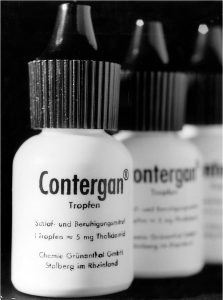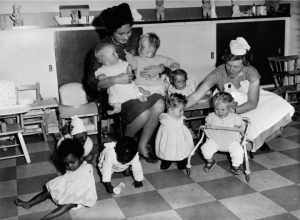Between 1957 and 1961, countless pregnant women were given a new miracle cure for morning sickness. Marketed in 46 countries under 37 brand names, they all contained the same active ingredient, a name that today evokes horror: thalidomide. More than 10,000 babies were born with severe birth defects; half of them died. But uniquely, one country was spared this tragedy—the USA—and it was all thanks to one person: Frances Oldham Kelsey, the Food and Drug Administration (FDA) reviewer who refused to approve it. Today she is remembered as the heroine who saved her country from a scourge that swept the world.

In 1953, the Swiss pharmaceutical company Chemische Industrie Basel synthesised a new compound but found no use for it as it had no effect on animals. The compound was then acquired by the German pharmaceutical company Chemie Grünenthal, owned by a former Nazi Party member who employed doctors responsible for war crimes and concentration camp experiments. At Grünenthal, the compound—thalidomide—was further studied as a by-product of research into glutamic acid, a brain neurotransmitter. Thalidomide was found to have sedative properties, and a patent was filed in 1954.
The second best-selling drug after aspirin
Thalidomide went on the market in West Germany on 1 October 1957 under the brand name Contergan. It was sold as a non-addictive sedative for anxiety and as a sleeping pill. Animal studies had not found a lethal dose and it was therefore considered safe. According to Grünenthal, the company did not indicate its use for nausea in pregnant women, but doctors soon discovered that it was useful in such cases, even though it had not even been tested on pregnant animals.

So successful was thalidomide, which was cheap and available over the counter in Germany, that it became the country’s second best-selling drug after aspirin. Nearly 15 tons were sold in 1960, and it was consumed at a rate of one million doses a day. It quickly spread to other countries with aggressive promotional campaigns that included handing out free samples to patients. Many women took it, confident because they had received it from their own doctor. Who could take better care of their baby?
In September 1960, the FDA received an application for approval from the William S. Merrell Company, which had licenced thalidomide from Grünenthal, to market it in the US under the brand name Kevadon. The application was the first to be assigned to a new physician and pharmacologist at the agency named Frances Oldham Kelsey (24 July 1914 – 7 August 2015), who had joined the FDA the previous month. Kelsey could have simply signed off on the approval; the drug was already being sold in many countries in Europe, Africa and South America, as well as in Canada. But she didn’t.

Kelsey was new to the FDA, but far from a rookie. Born in British Columbia, Canada, she graduated with a degree in pharmacology in her native country and then landed a research position at the University of Chicago, which she was offered in the confusion that “Frances” was a male name; she would later write: “I do not know if my name had been Elizabeth or Mary Jane, whether I would have gotten that first big step up.” Her first exposure to drug safety came in 1937, when she participated in an investigation for the FDA into 107 deaths linked to the consumption of Elixir Sulfanilamide, a sulfonamide antibiotic preparation containing the toxic solvent diethylene glycol (used in antifreeze). During her time at Chicago, Kelsey earned her Ph.D. in pharmacology, joined the university faculty, married a fellow faculty member, Fremont Kelsey, had two daughters, and earned her medical degree.
Kelsey’s big decision
It was in Chicago that her interest in teratogens, compounds that cause congenital malformations, was born. In 1942, during the Second World War, the US was looking for a substitute for quinine to combat malaria in its troops in Asia. Kelsey reported that a veterinarian in Texas had sent a possible antimalarial that he claimed to have tested on his secretary with no adverse effects, and which he planned to test on cows. “It showed the relative value placed on women and cattle in Texas at that time,” she would joke years later.
But during those studies, Kelsey discovered that some drugs, such as quinine, crossed the placental barrier from mother to foetus, and that rabbit embryos could not metabolise it like adult animals. So when she received the FDA’s application for approval of thalidomide, she was suspicious. “They gave it to me because they thought it would be an easy one to start on,” she would say years later. “As it turned out, it wasn’t all that easy.”

Safety data on thalidomide were insufficient, and a letter published in the British Medical Journal linked it to nerve damage. Kelsey also wanted to see data on safety for the foetus, which was lacking. Despite mounting pressure from the pharmaceutical company, she repeatedly refused to sign off on the approval. Finally, the scandal of birth defects and miscarriages broke, and thalidomide was banned between November 1961 and 1962. By then 300 million tablets had been sold.
The thalidomide tragedy and Kelsey’s unwavering heroism led to changes in drug safety legislation, in which she herself participated. In 1962, she received the President’s Award for Distinguished Federal Civilian Service from President John F. Kennedy—only the second woman to receive it—along with numerous other awards and widespread public recognition. But not even in her 101 years of life could she be rewarded for the suffering she spared thousands of people.
Comments on this publication